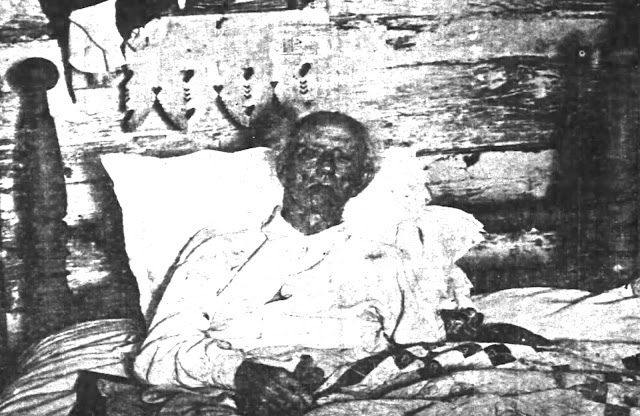 |
| In 1897, the Louisville Courier-Journal propped up a frail Austin Gollaher in his bed for this photo. (Newspapers.com) |
Lincoln apparently never mentioned the event during his presidency. In an 1889 Lincoln biography by William Herndon, the president's former law partner, the drowning story earned two sentences. Respected 21st-century Lincoln scholar Michael Burlingame also briefly mentioned the story in his Lincoln biography. His sources were two Gollaher interviews. Based solely on Gollaher's account, the drowning story appeared in many late-19th century newspapers throughout the United States.
But there's no doubt Lincoln and Gollaher were close at one time. "I would rather see Gollaher than than any man living," Lincoln said while in the White House.
So, does this story, ahem, hold water?
 |
| Knob Creek, where Lincoln played as a youth--and may have nearly drowned. |
 |
| An illustration of the rescue at Knob Creek published in the St. Louis Globe-Democrat on Feb. 7, 1954. |
To learn more about Lincoln's childhood playmate, I dived into the swimming rabbit hole of newspapers.com. One story—a lengthy feature published in the the Louisville Courier-Journal on Sept. 26, 1897—captured my attention. By then, the once-heavyset, tobacco-chewing Gollaher—"Uncle Austin" to those who knew him well—apparently was on his deathbed. A devout Christian, Gollaher suffered from rheumatism, among other ailments.
 |
| An image of Austin Gollaher published in the St. Louis Globe-Democrat on Feb. 7, 1954. |
I don't think my 20th-century journalism professors would approve of that lede.
In a weak, halting voice, Uncle Austin talked about attending school with his friend, protecting him against bullies, and about the near-drowning—Abraham "spit up about two quart [of water]" after his rescue, Uncle Austin said. Gollaher "brightened up" when asked about Lincoln and his sister, Sarah, a "purty gal" who also went by "Sally." "We were sweethearts then," he told the reporter.
The Courier-Journal even propped up the frail Gollaher for a photograph in his bed at the spartan, backwoods house where he lived with his son. Reported the newspaper:
"As the artist's camera was placed and brought into range with the old man his talk drifted back to the war at the sight of what he took to be a gun. The sudden explosion of the flash-light powder caused him a geniune shock. However, be it said to his credit as a warrior, he was not alarmed beyond the first surprise. He merely gave one tremendous lurch: then, shading his eyes with his hand and peering sharply at the instrument through the ascending smoke, in a cool, yet anxious voice, he asked: 'Did you hit anybody that time?' and receiving in reply the assurance that it was only target practice."
Courier-Journal be damned, Gollaher hung on until Feb. 21, 1898. He left seven children, dozens of grandchildren, and a story that, if true, changed history.
After a visit to the Lincolns' Knob Creek Farm, I paid respects at Gollaher's grave at Pleasant Grove Baptist Cemetery, near Hodgenville. Atop his marker I left a penny, Lincoln side up of course.
— Have something to add (or correct) in this post? E-mail me here.
SOURCE:
Burlingame, Michael. Abraham Lincoln: A Life, Volume One, Baltimore: John Hopkins University Press, 2008.
Great story!
ReplyDeleteInteresting, thanks.
ReplyDeleteEnjoyed! Thank you. I’m from Springfield, IL and had never heard this story. Interesting and well written.
ReplyDelete